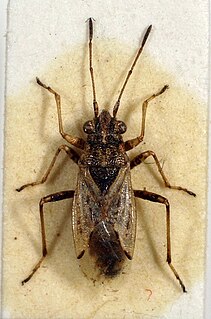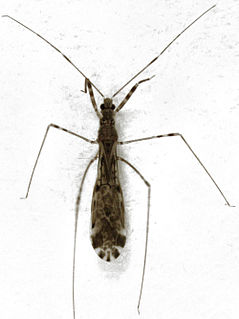Related Research Articles

The Reduviidae are a large cosmopolitan family of the order Hemiptera. Among the Hemiptera and together with the Nabidae almost all species are terrestrial ambush predators: most other predatory Hemiptera are aquatic. The main examples of nonpredatory Reduviidae are some blood-sucking ectoparasites in the subfamily Triatominae. Though spectacular exceptions are known, most members of the family are fairly easily recognizable; they have a relatively narrow neck, sturdy build, and formidable curved proboscis. Large specimens should be handled with caution, if at all, because they sometimes defend themselves with a very painful stab from the proboscis.

Nysius is a genus of false chinch bugs in the family Lygaeidae. There are at least 100 described species in Nysius.

The Emesinae, or thread-legged bugs, are a subfamily of the Reduviidae. They are conspicuously different from the other reduviids by their very slender body form. They are stalking, predatory insects that can be collected on palm fronds, cliffs, spider webbing, or near lights at night. They walk on their mid and hind legs; the front pair is raptorial. Some groups specialize on spiders. Very little is known about emesines except that many species are found in the tropics. Pedro Wygodzinsky wrote the most recent revision of this group.

Water treaders, the superfamily Mesovelioidea, are insects in the order Hemiptera, the true bugs. They are semiaquatic insects that live in moist and wet habitat and on wet plant matter in several types of aquatic habitat.
Sigmatineurum is a genus of fly in the family Dolichopodidae. It is endemic to Hawaii, occurring on all the main islands in the archipelago. It is part of the Eurynogaster complex of genera.
Ghilianella is a genus of true bug in the subfamily Emesinae. Fifty-eight species have been described, with a distribution from Guatemala to Brazil. The linear form of the species in this genus allow the young larvae to be carried about by the mother or perhaps the father. The larvae of the young can curl around the parent's thorax.
Ghilianella borincana is a species of true bug found in semi-evergreen forest of Puerto Rico. It is highly cryptic, using catalepsis.

Ploiaria is a cosmopolitan genus of thread-legged bugs (Emesinae). There are presently about 130 described species.

Ploiariolini is a tribe of thread-legged bugs, comprising 16 genera and 142 described species. Ploiariolini has a worldwide distribution.

Emesopsis is a genus of tropical bugs (Heteroptera) from the family Reduviidae. There are at least 22 described species, of which one, E. nubila, also occurs in southern Europe.
Bagauda is a genus of thread-legged bug in the Emesinae. 18 species are currently known. Many of the species of this genus are associated with caves, some exclusively so. Bagauda is synonymous with the genus Pleias Kirkaldy, 1901, but Bagauda has become more widely used. The genus is restricted to Old World tropics.
Emesa tenerrima is a thread-legged bug from the genus Emesa. It is found in semi-evergreen forest in Puerto Rico. E. tenerrima lives in the webs of the spider Modisimus signatus which it also physically resembles.
Chinemesa is a little-known genus of thread-legged bug (Emesinae) apparently endemic to Borneo. Only four species have been described and the three described by Wygodzinsky in 1966 have not been observed since.
Phasmatocoris is a little-known genus of thread-legged bug (Emesinae). Fourteen species have been described, including 3 from Colombia.

Barce is a genus of thread-legged bugs in the family Reduviidae. There are about six described species in Barce.
Onychomesa is a little-known genus of thread-legged bug in the subfamily Emesinae. Three species have been described, one from India, Japan, and Taiwan.

Saicinae is a subfamily of the family Reduviidae, or the assassin bugs.

LopodytesRondani 1867 is a genus in the family Reduviidae, the assassin bugs. Members of the genus have been unofficially assigned the common name Grass Assassin bugs, but generally this name remains meaningful only to naturalists, because these insects have been too well camouflaged to raise robust public awareness.

Hermatobates is a genus of wingless marine bugs placed as the sole genus in the family Hermatobatidae that are sometimes known as coral-treaders. They are quite rare and known only from coral reefs in the Indo-Pacific region. During low tide, they move over the water surface not unlike the more familiar water-striders around coral atolls and reefs and stay submerged in reef crevices during high tide.
P. S. Nathan, P. Susai Nathan or P. Susainathan was an Indian naturalist, entomologist and a natural history specimen collector and dealer. His natural history business was continued by his daughter-in-law Theresa Rajabai Susai Nathan and still later by her daughter-in-law Nellie J.P. Nathan. A number of species are named after the collections made by him and his family.
References
- ↑ Robert L. Usinger (1958). "A New Genus of Reduviidae from the Hawaiian Islands (Hemiptera)" (PDF). Proceedings of the Hawaiian Entomological Society. 16 (3): 437–440.
- ↑ D. A. Polhemus (2000). "A revision of the endemic hawaiian genus Saicella Usinger, with descriptions of four new species (Heteroptera: Reduviidae: Emesinae)". Proceedings of the Entomological Society of Washington. 102 (1): 1–20.